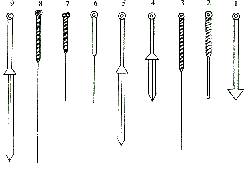Needling Techniques of Chinese Acupuncture Stimulation
 |
The "Nine needles" in Lingshu |
No one knows when exactly acupuncture was first used in medical treatment, but it definitely is well before recorded history. Unearthed relics show that ancient people used sharpened stones, bamboo and animal bones to perform the needling techniques. Nowadays, most modern physicians use sterile and disposable metallic needles of various lengths and thicknesses, so that they can be applied on different part of the body. In Chinese acupuncture practice, the commonly used needle size is 1.5 inches (40 mm) in length.
Since the needles are long, fine and soft, strong and skillful hand manipulations are needed to ensure the needles insert smoothly and precisely into the skin with little pain. Proficient acupuncturists have trained themselves to hold the needle freely. They are capable of inserting and removing the needles quickly, and also twirling or rotating the needles flexibly. They are also required to practice needle technique on their own bodies so as to experience the exact feeling of manipulation and stimulation that the recipient gets. Extensive training and practice is needed to become skillful in needle manipulation.
Basic Insertion Techniques
Due to the anatomical features of the acupoint, needle insertion technique varies. Traditionally, the needle is inserted using both hands. In one hand, physicians hold the needle between 15 degrees to 90 degrees to the skin surface. They also use their fingers to press, hold-up, or stretch the local skin surface and then guide the needle to be inserted in appropriate speed, force, depth and direction. Alternatively, a needling guide tube can be used. The needle is inserted into the tube and placed firmly on the point; physicians then tap firmly on the handle of needle so that it penetrates the skin. The guide is then removed and the needle is further adjusted as required.
After the needle is inserted, physicians will look for the appearance of needling sensation. TCM calls this deqi literally, the "arrival of qi". The patient may feel a dull ache, heaviness, distention, tingling, or electrical sensation either around the needle or traveling up or down the affected meridian. Meanwhile, the practitioner may experience tightness and dragging around the needle similar to a fish taking the bait. This needling sensation varies greatly from person to person. Pain is not an expected response to most acupuncture stimulation, though certain acupoints may be involve some occasional pain.
TCM focuses on this needling sensation, which is influenced by many factors, such as the constitution of a patient, severity of the illness, location of the acupoints and the needling techniques. In general, if the needling sensation occurs easily and the qi can travel to stimulate the lesion, the therapeutic effect will be better; if qi is difficult to secure, then the effect is not so good. For individuals who get this sensation slowly or faintly, the physician will further manipulate to adjust the position, direction and depth of the needle; this includes techniques like lifting and thrusting the needle into place, twirling the needle in a specific manner, plucking or scraping the handle of the needle, and also pressing the skin up and down along the course of the meridian with the fingers.
Once again, techniques are carefully chosen based on the condition of the patient and the location of the acupoints. Common factors to determine the needling techniques include: those with strong bodies or the more muscular regions may be inserted deeper and can accept more vigorous techniques; while the elderly, small children and those with weakened bodies, and for those regions with a thin skin layer should have shallower needle insertions and be stimulated more gently.
 |
Different ways of needle insertions |
|